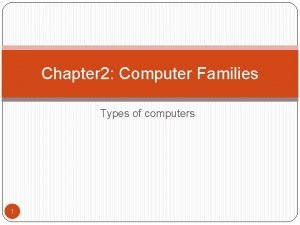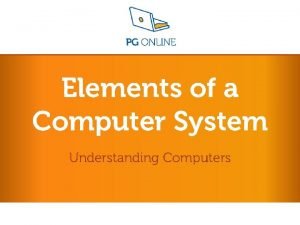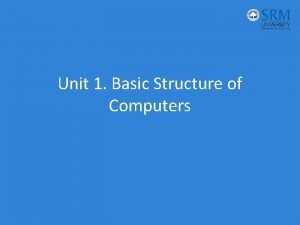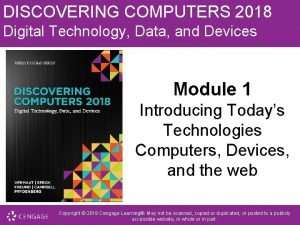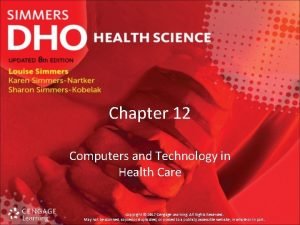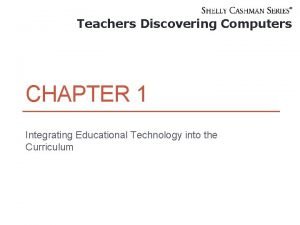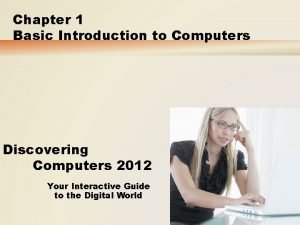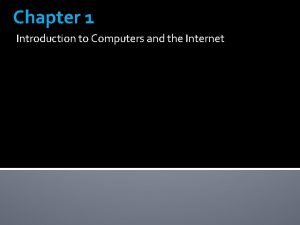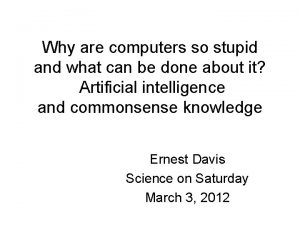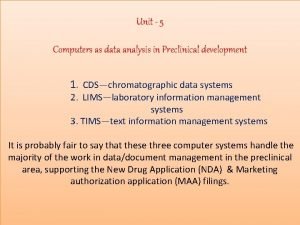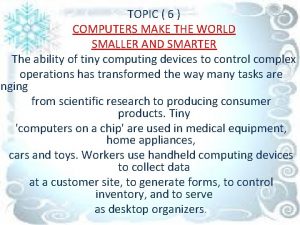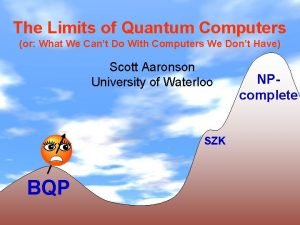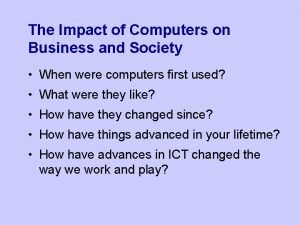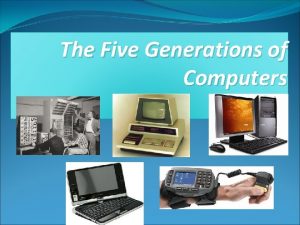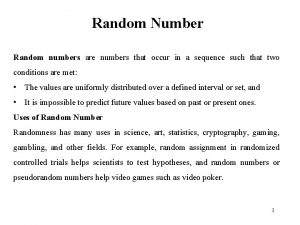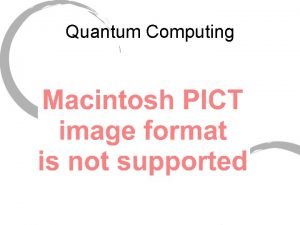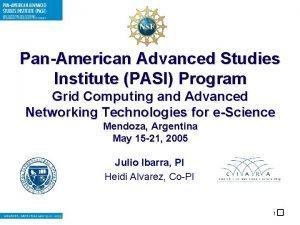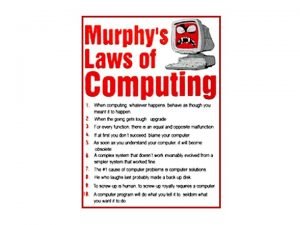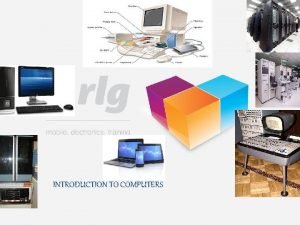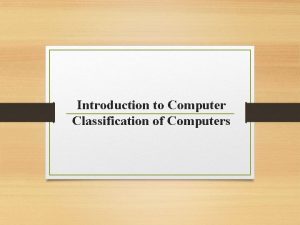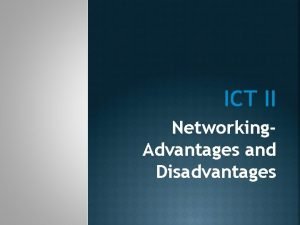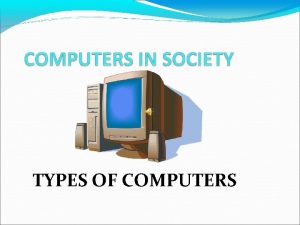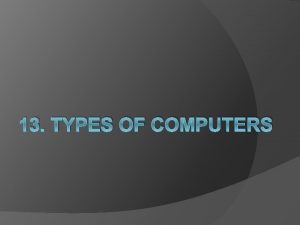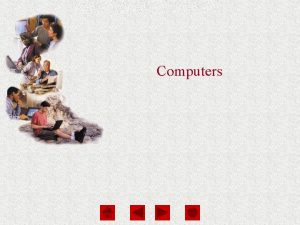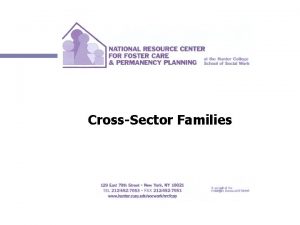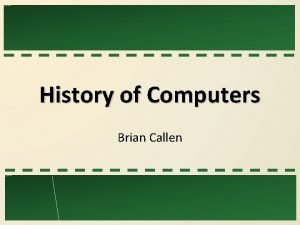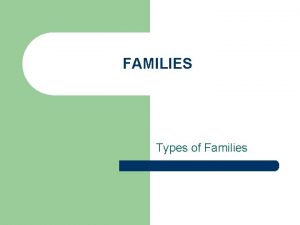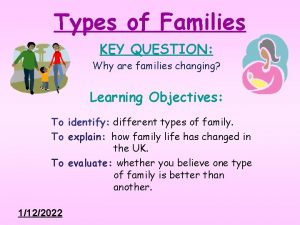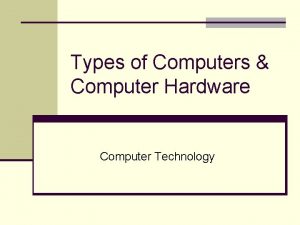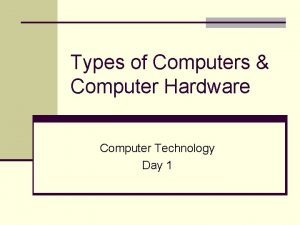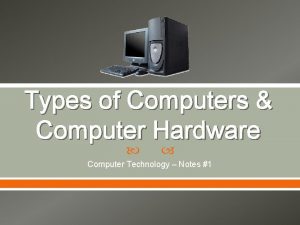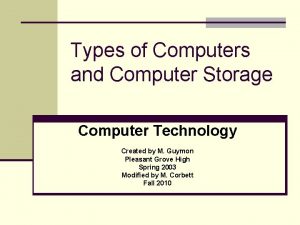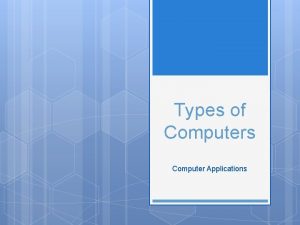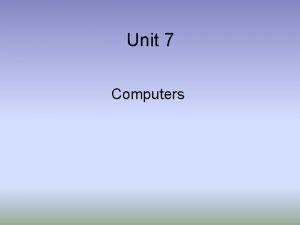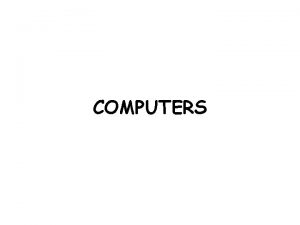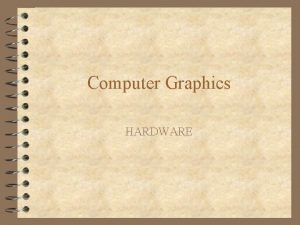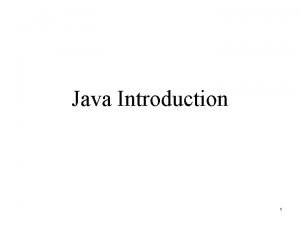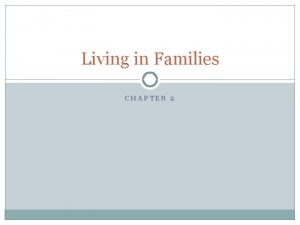Chapter 2 Computer Families Types of computers 1





























- Slides: 29

Chapter 2: Computer Families Types of computers 1

Chapter objectives v Types of computers v Supercomputers v Mainframes v Minicomputers v Networks v Personal computers v Personal digital assistant v The Internet v Intranets v Extranets v. Humans or computers 2

Types of computer v Are you new to computers? Do you wonder what they do and why you would want to use one? v What they are, the different types, and what you can do with them? v What is Computer? Ø Computers are machines that perform tasks or calculations according to a set of instructions, or programs. All computers are systems of input, processing, output, storage, and control components. Computers work through an interaction of hardware and software. 3

Basic of Computer v Hardware refers to the parts of a computer that you can see and touch, including the case and everything inside it. The most important piece of hardware is a tiny rectangular chip inside your computer called the central processing unit (CPU), or microprocessor. It's the "brain" of your computer the part that translates instructions and performs calculations. Ø Hardware items such as your monitor, keyboard, mouse, printer, and other components are often called hardware devices. v Software refers to the instructions, or programs, that tell the 4 hardware what to do. A word-processing program that you can use to write letters on your computer is a type of software. The Operating System (OS) is software that manages your computer and the devices connected to it. Windows is a well-known operating system. The first fully electronic computers, introduced in the 1940 s. Computers work through an interaction of hardware and software.

Supercomputer v Are extremely powerful machines that can be general– 5 purpose machines (like mainframes) designed to complete different types of tasks, or specific–purpose machines that have been designed to perform a particular type of task (e. g. , solve specific types of mathematical equations) v Mathematical calculations necessary for accurate weather forecasting for the evening news broadcast. v Supercomputers are extremely expensive machines. Thus, in most cases they can be afforded only by governments, universities and very large corporations. v In smaller companies so that they can have complex problems solved in time without having to purchase a

Supercomputer � Some uses of a supercomputer could be Predicting the weather, Researching climate change, Physical simulations 6

Mainframes v A mainframe is a computer to which thousands of terminals can be connected so that thousands of users work at the same time. v Mainframes are normally used by large corporations with tens of thousands of employees and government agencies. IBM is the largest manufacturer of mainframe computers in the world. v Some uses of a mainframe could be: 1. Processing incoming stock trades at a bank 2. Running an Internet server at an online auction Web 7 site 3. Replacing a large number of smaller servers at a large business

Mainframes 8

Minicomputers v A minicomputer is a computer to which tens or hundreds of terminals can be connected so that tens or hundreds of users work at the same time. That is, a minicomputer is like a mainframe, but it is less powerful. v Minicomputers normally are used by medium size corporations, by departments of large corporations and departments of government agencies. IBM, Hewlett– Packard and Digital manufacture minicomputers. 9

Minicomputers 10

Network v A computer network is a group of computers that have been interconnected with one another for the purpose of sharing data or devices. v A network can be as simple as two desktop PCs sharing a printer or as complex as several hundred or even thousands of machines, some of which could be notebooks, desktop PCs, minicomputers, mainframes or supercomputers. 11

Network v SERVERR on a local area network (LAN), a computer running administrative software that controls access to the network and its resources, such as printers and disk drives, 2. provides resources to computers functioning as workstations on the network. On the Internet or other network, a computer or program that responds to commands from a client. 1. v For example, a file server may contain an archive of 12 data or program files; when a client submits a request for a file, the server transfers a copy of the file to the client. See also application server (definitions 1 and 2), client/server architecture. Compare client (definition 3).

Network 13

Personal Computer v Is a personal computer is like a mainframe or a minicomputer with only one user. v Its name “personal computer” or “PC” for short. Of course, since it has to serve the needs of only one user, a personal computer has less computing power than a minicomputer or a mainframe. v PCs can be used to run company departments or small businesses. v PCs are manufactured by companies like IBM, Compaq, Hewlett–Packard, Dell, etc. v PCs can be desktop PCs, notebooks or palmtops. A desktop PC is a PC designed not to be portable but to 14 sit on your desk

Personal Computer v In a desktop PC, the computer, screen monitor and keyboard come as three separate pieces of hardware. 15

Laptop Computers v Laptop computers are lightweight mobile PCs with a thin screen. v Laptops can operate on batteries, so you can take them anywhere. v Unlike desktops, laptops combine the CPU, screen, and keyboard in a single case. The screen folds down onto the keyboard when not in use. v Small notebook PCs (often referred to as mininotebooks), are small, affordable laptops that are designed to perform a limited number of tasks v they're used mainly to browse the web and check e‑mail. 16

Laptop Computers 17

Palmtop v A palmtop is a PC of reduced size that can be held on one’s hand. Palmtops offer great portability, but sacrifice screen size and the comfort of a regularly sized keyboard. Popular palmtops include those manufactured by Hewlett–Packard. 18

Personal Digital Assistant v Personal digital assistant (PDA) is a small mobile hand held device that allows you to store and retrieve information for personal or business use. v A PDA is commonly used for keeping track of your appointments, addresses, telephone numbers, email addresses, play music, and record voice memos. v PDAs allow you to retrieve your emails, and get access to the Internet by either connecting to a telephone jack, (where by a special modem may need to be purchased), or wirelessly by buying a wireless modem or by connecting to certain types of digital mobile phones. For this type of connection you need to 19 subscribe to a wireless data network service.

Personal Digital Assistant v PDAs work on operating system) or palm operating system: � Windows–based (Windows CE). �I/OS �Android 20

The Internet v The Internet consists of thousands of computers of all types around the world which are interconnected in a variety of ways (e. g. , through the telephone system or through cable) so that they can send and receive data. v These computers are called Internet servers, and they reside in universities, government agencies, corporations and other organizations. v You do not need to have an Internet server to connect to the Internet and thus send or receive, for example, electronic mail to and from other people also connected to the Internet. 21

The Internet 22

The Internet v Users can connect to an Internet server maintained and serviced by a company which is an Internet service provider (ISP). For a monthly or yearly fee, you can connect to the Internet server of an ISP through the telephone line via a modem attached to your PC, optic cable, and wireless v Once you are connected to the Internet, you can send and receive electronic mail, see on your screen the pages of information, advertisements, job offerings, product catalogues, etc. that tens of thousands of different companies have posted on the Internet’s World Wide Web (WWW), etc. 23

Intranet v Intranets are proprietary, smaller versions of the Internet. A large company may decide to post a corporate directory of names, positions, addresses and phone numbers of its employees on the Internet for all employees to see. v Internet users to access that information, it may decide to create its own private Internet (an intranet) to which only company employees have access. 24

Intranet 25

Extranet v Extranets are similar to Intranets, which are proprietary smaller versions of the Internet. Typically large companies provide services to their employees over the corporate Intranet. v An Extranet uses various Internet protocols, telecommunications systems and security measures to allow employees to securely access the Intranet remotely. 26

Human or Computer v Humans are excellent at performing creative tasks. v However, in the modern computing environment computers perform many tasks that a human would either not want to do, or not be capable of doing. v For example, consider a bank that receives orders for stock market trades. v The bank may receive several thousand requests per second, a rate that no human could keep up with. Also, the trade would have to be executed exactly as requested, any mistakes could cost money. v A computer excels at tasks like these. A computer is not capable of creating quality, unique commentary that a human would want to read. A computer could not 27 provide insight into the words and actions of a human.

Reference �Book or E-book 1. BBU, Using Information Technology, Stacey C. Sawyer & Brian K. Williams, 2005 2. E-book, Information Technology for Management, Turban Mc. Lean Wetherbe 3. E-book, Module 1: Concepts of IT (Information Technology), alignmedia , Copyright © 1992– 2006 Align Media Inc. �Web site 1. http: //en. wikipedia. org/ 2. http: //www. intel. com 3. http: //www. jegsworks. com 28

The END Thank You 29
 Big families vs small families
Big families vs small families Computer families
Computer families The elements of a computer
The elements of a computer The basic structure of computer was developed by
The basic structure of computer was developed by Discovering computers 2018 ppt
Discovering computers 2018 ppt Chapter 12 computer and technology in health care
Chapter 12 computer and technology in health care Discovering computers 2018 chapter 1
Discovering computers 2018 chapter 1 Discovering computers
Discovering computers Chapter 1 introduction to computers and programming
Chapter 1 introduction to computers and programming Computer programming chapter 1
Computer programming chapter 1 Mainframe computer definition and examples
Mainframe computer definition and examples Chapter 1 introduction to computers and programming
Chapter 1 introduction to computers and programming C programming chapter 1
C programming chapter 1 Write reasons for the changes in families class 4
Write reasons for the changes in families class 4 Chapter 10 western musical instruments
Chapter 10 western musical instruments Chapter 7 sports and entertainment marketing
Chapter 7 sports and entertainment marketing Google translate french to english
Google translate french to english Site:slidetodoc.com
Site:slidetodoc.com Computer science ucl
Computer science ucl The ability of tiny computing devices
The ability of tiny computing devices The limits of quantum computers
The limits of quantum computers What is the impact of computers on business
What is the impact of computers on business What are the five generations of computers
What are the five generations of computers How do computers get random numbers
How do computers get random numbers Quantum binary
Quantum binary Panamerica computers
Panamerica computers Murphy's law computers
Murphy's law computers Peripheral device
Peripheral device Mainframe computer definition and examples
Mainframe computer definition and examples Ictii
Ictii

